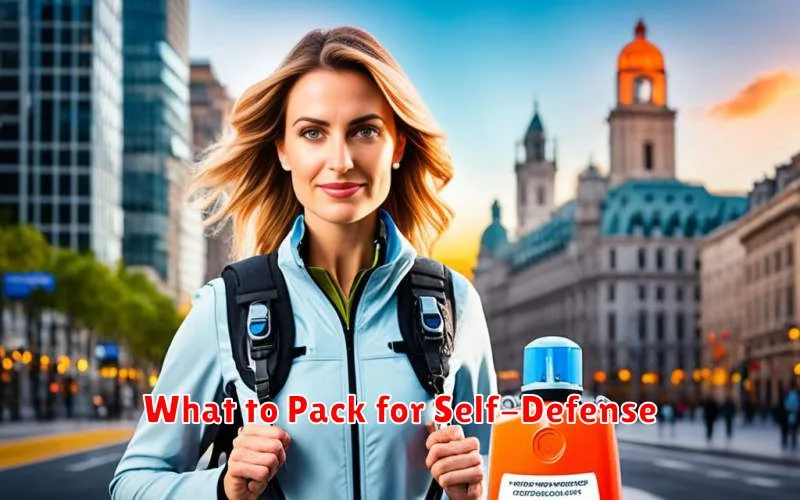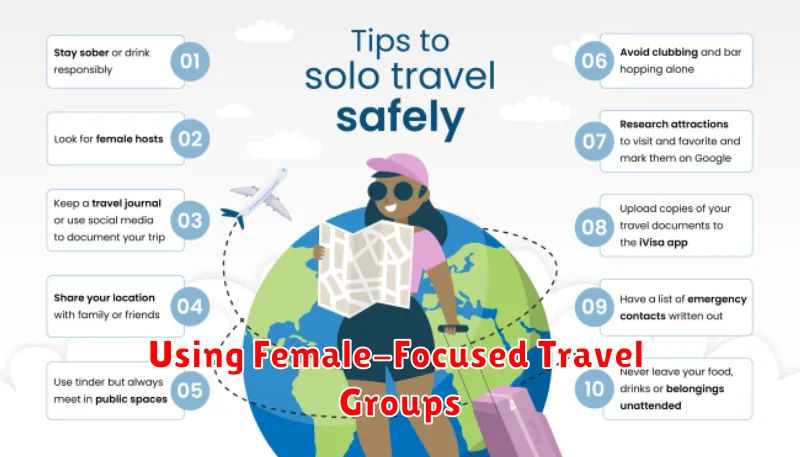Embarking on a solo female travel adventure can be incredibly rewarding, offering unparalleled opportunities for self-discovery, exploration, and personal growth. However, it’s essential to prioritize safety and take necessary precautions to ensure a smooth and enjoyable journey. This article will provide you with comprehensive information and practical tips to navigate the world confidently and securely as a solo female traveler, addressing key concerns and empowering you to make informed decisions every step of the way. From pre-trip planning to on-the-ground strategies, we’ll cover essential aspects of solo female travel safety.
Whether you’re a seasoned traveler or planning your first solo trip, understanding potential risks and implementing effective safety measures is paramount. We’ll delve into crucial topics such as destination research, accommodation choices, transportation options, communication strategies, and personal safety techniques. By equipping yourself with the knowledge and resources provided here, you can mitigate potential challenges, enhance your travel safety, and fully embrace the enriching experience of solo female travel.
Planning a Safe Trip as a Woman
Traveling as a woman requires extra vigilance. Research your destination thoroughly, noting local customs and laws, particularly regarding women’s safety. Identify safe neighborhoods and transportation options. Share your itinerary with a trusted contact and check in regularly. Consider learning basic self-defense techniques and carrying a personal safety alarm. Pack lightly to avoid struggling with luggage and maintain situational awareness at all times.
Secure your accommodations and belongings. Choose reputable hotels or rentals with good security measures. Utilize hotel safes for valuables like passports, extra cash, and jewelry. Be cautious about sharing personal information with strangers and avoid displaying expensive electronics or jewelry. Keep your belongings close to you at all times, especially in crowded areas or on public transportation.
Trust your instincts. If a situation feels unsafe, remove yourself immediately. Don’t hesitate to ask for help from local authorities or hotel staff. Be assertive and confident in your interactions. Pre-plan potential escape routes or meeting points in case of emergencies. Staying informed and aware is the key to a safe and enjoyable trip.
Clothing and Cultural Awareness
Clothing plays a significant role in expressing cultural identity and values. Different cultures have unique dress codes and traditions, often reflecting religious beliefs, social status, or historical events. Being aware of these differences demonstrates respect and promotes understanding in cross-cultural interactions. Failing to acknowledge these nuances can lead to misunderstandings or even offense. Sensitivity and a willingness to learn about diverse clothing customs are crucial in navigating a globally connected world.
Understanding cultural attire goes beyond simply recognizing differences. It involves appreciating the meaning behind clothing choices. For instance, certain colors, fabrics, or styles might hold symbolic importance in specific cultures. While travelers are not expected to fully adopt local dress, showing respect through modest attire or avoiding culturally sensitive items demonstrates cultural awareness and fosters positive interactions. This can be as simple as researching local customs before traveling or asking questions when uncertain.
Ultimately, cultural awareness surrounding clothing promotes inclusivity and breaks down barriers. By recognizing and respecting the diverse ways people express their cultural identity through dress, we contribute to a more tolerant and understanding society. Educating ourselves about these differences enables us to build stronger relationships and navigate intercultural encounters with greater sensitivity and respect.
What to Pack for Self-Defense

Personal safety is paramount, especially when traveling or navigating unfamiliar environments. While avoiding dangerous situations is always the best strategy, carrying a few carefully selected self-defense tools can provide an added layer of security. Legal and readily accessible options include a personal safety alarm, a high-powered flashlight, and pepper spray (where legal). These items can disorient an attacker, attract attention, and create an opportunity to escape. Remember to familiarize yourself with the local laws regarding self-defense tools before carrying them.
Beyond physical tools, consider equipping yourself with knowledge and skills. Self-defense training can empower you with the confidence and techniques to react effectively in threatening situations. Basic awareness of your surroundings and practicing assertive communication can also help deter potential threats. Being prepared mentally and physically can make a significant difference in your ability to stay safe.
Packing for self-defense is not about becoming overly fearful or aggressive. It’s about being proactive and prepared. Just as you pack necessary items for your physical comfort and well-being, consider incorporating these simple tools and strategies to enhance your personal safety.
Avoiding Risky Situations
Risk avoidance is a crucial aspect of personal safety and well-being. It involves identifying potential hazards and taking proactive steps to steer clear of them. By assessing situations for potential dangers, you can significantly reduce your likelihood of experiencing negative consequences such as accidents, injuries, or other harmful incidents. This involves cultivating a mindset of awareness and preparedness.
Practical steps for avoiding risky situations include trusting your instincts. If a situation feels unsafe, it’s often best to remove yourself. Planning ahead is also essential. Before engaging in any activity, research potential risks and take necessary precautions. Additionally, maintain situational awareness by paying attention to your surroundings and being mindful of potential threats. This includes being aware of who and what is around you.
Furthermore, it’s important to set boundaries and learn to say no to activities that make you uncomfortable. Seeking information and advice from trusted sources can also help you make informed decisions about potential risks. Finally, remember that risk avoidance is an ongoing process. Continuously evaluating situations and adjusting your behavior accordingly will enhance your safety and contribute to your overall well-being.
Using Female-Focused Travel Groups

Female-focused travel groups offer a unique and empowering way for women to explore the world. They provide a supportive and encouraging environment where women can connect with like-minded individuals, share experiences, and build lasting friendships. These groups often cater to specific interests, such as adventure travel, cultural immersion, or wellness retreats, allowing women to choose experiences that align with their passions. Furthermore, traveling with a female-focused group can enhance safety and security, particularly in destinations where solo female travel might present challenges.
Joining a female-focused travel group can simplify the travel planning process. These groups typically handle the logistics, including accommodations, transportation, and activities, allowing participants to relax and enjoy the journey. This is particularly appealing for women who are new to traveling or prefer a more structured itinerary. Moreover, these groups often provide access to unique experiences and local insights that might be difficult to arrange independently. They might offer opportunities to connect with local women, learn about different cultures firsthand, or participate in activities that are specifically designed for female travelers.
When selecting a female-focused travel group, it is crucial to consider your travel style, budget, and interests. Research different groups to find one that aligns with your preferences. Look for reviews and testimonials from previous participants to get a sense of their experiences. It’s also important to understand the group’s philosophy and values to ensure they are a good fit for you. By carefully considering these factors, you can choose a group that will provide a memorable and fulfilling travel experience.
Handling Harassment Abroad
Experiencing harassment while traveling can be distressing. If you find yourself in this situation, prioritize your safety. If you feel physically threatened, remove yourself from the situation immediately and seek help from local authorities. Document the incident as thoroughly as possible, including times, dates, locations, and descriptions of the individuals involved. If possible, gather evidence such as photos or videos (if safe to do so). Depending on the severity of the harassment, contacting your embassy or consulate can provide valuable assistance and resources.
Understanding local laws and customs can help you navigate challenging situations. While certain behaviors might be considered harassment in your home country, they may not be viewed the same way in other cultures. Researching local customs before you travel can prepare you for potential cultural differences and help you avoid unintentional misunderstandings. However, this does not excuse harmful or threatening behavior, and you should still prioritize your safety and well-being.
Prevention is key. Be aware of your surroundings and avoid walking alone in isolated areas, especially at night. Share your itinerary with someone you trust back home and maintain regular contact. Consider learning basic phrases in the local language that can be helpful in emergency situations. Projecting confidence and assertiveness can sometimes deter unwanted attention. Trust your instincts – if a situation feels uncomfortable, it probably is. Remove yourself from the situation.
Returning Home with Confidence
Returning home after a long absence can be both exciting and daunting. Whether you’ve been away for travel, work, or other reasons, reintegrating into your familiar environment requires preparation and a positive mindset. Consider the practical aspects of your return: confirming housing arrangements, reconnecting utilities, and notifying relevant institutions of your arrival. Addressing these logistical details beforehand will alleviate potential stress and ensure a smoother transition.
Beyond the practicalities, reconnect with your support network. Reach out to family and friends, and schedule time to spend with them. Sharing your experiences and re-establishing these connections will help you feel grounded and reintegrated into your community. Remember to be patient with yourself as you readjust to your former routines and surroundings. It’s normal to experience a period of adjustment, so allow yourself time to settle back in and find your rhythm.
Finally, embrace the opportunity for reflection and growth. Time away often provides new perspectives and insights. Consider how your experiences have shaped you and how you can incorporate these lessons into your life moving forward. Returning home isn’t just about picking up where you left off; it’s about integrating your experiences and moving forward with renewed confidence and purpose.

